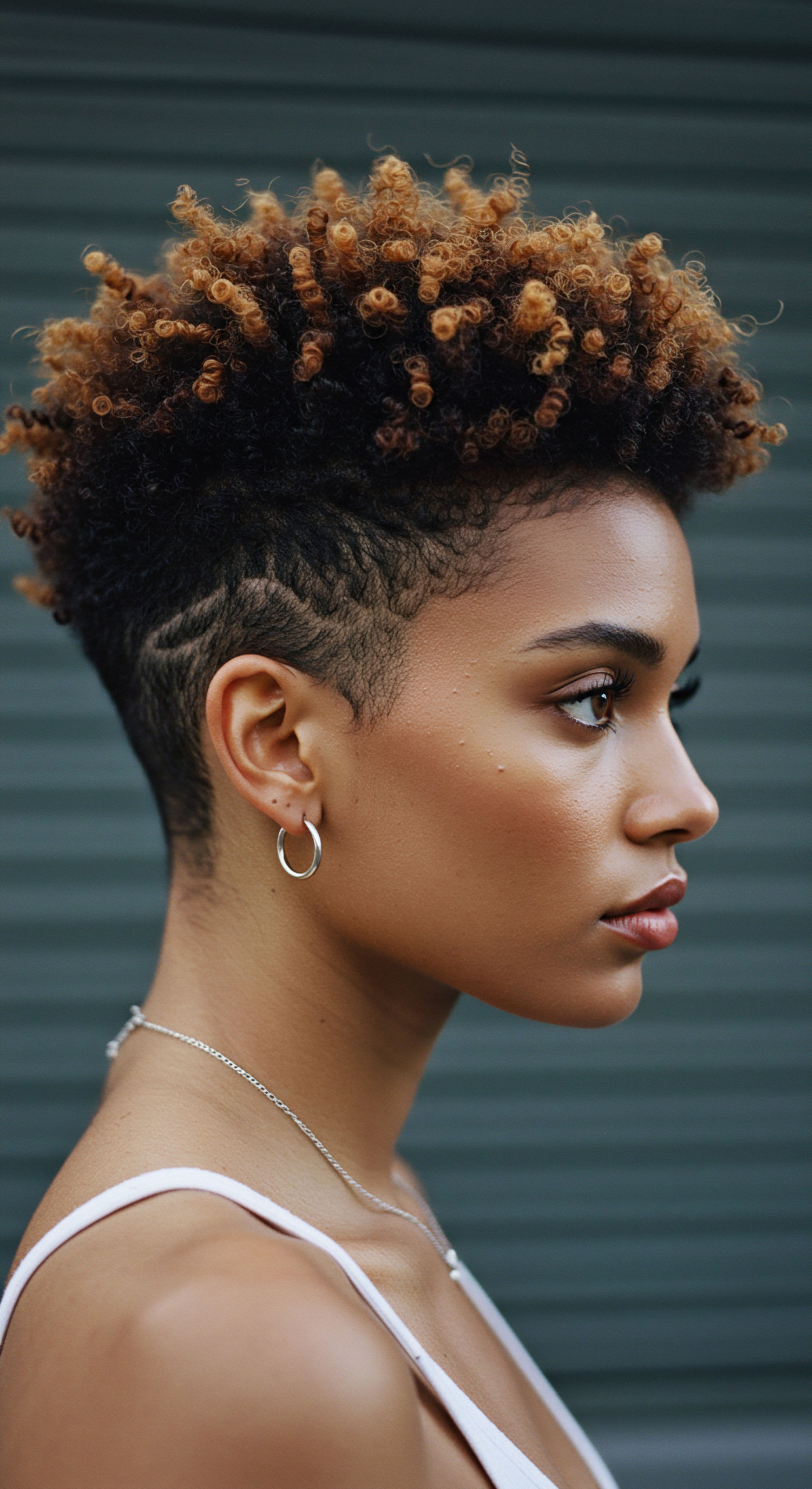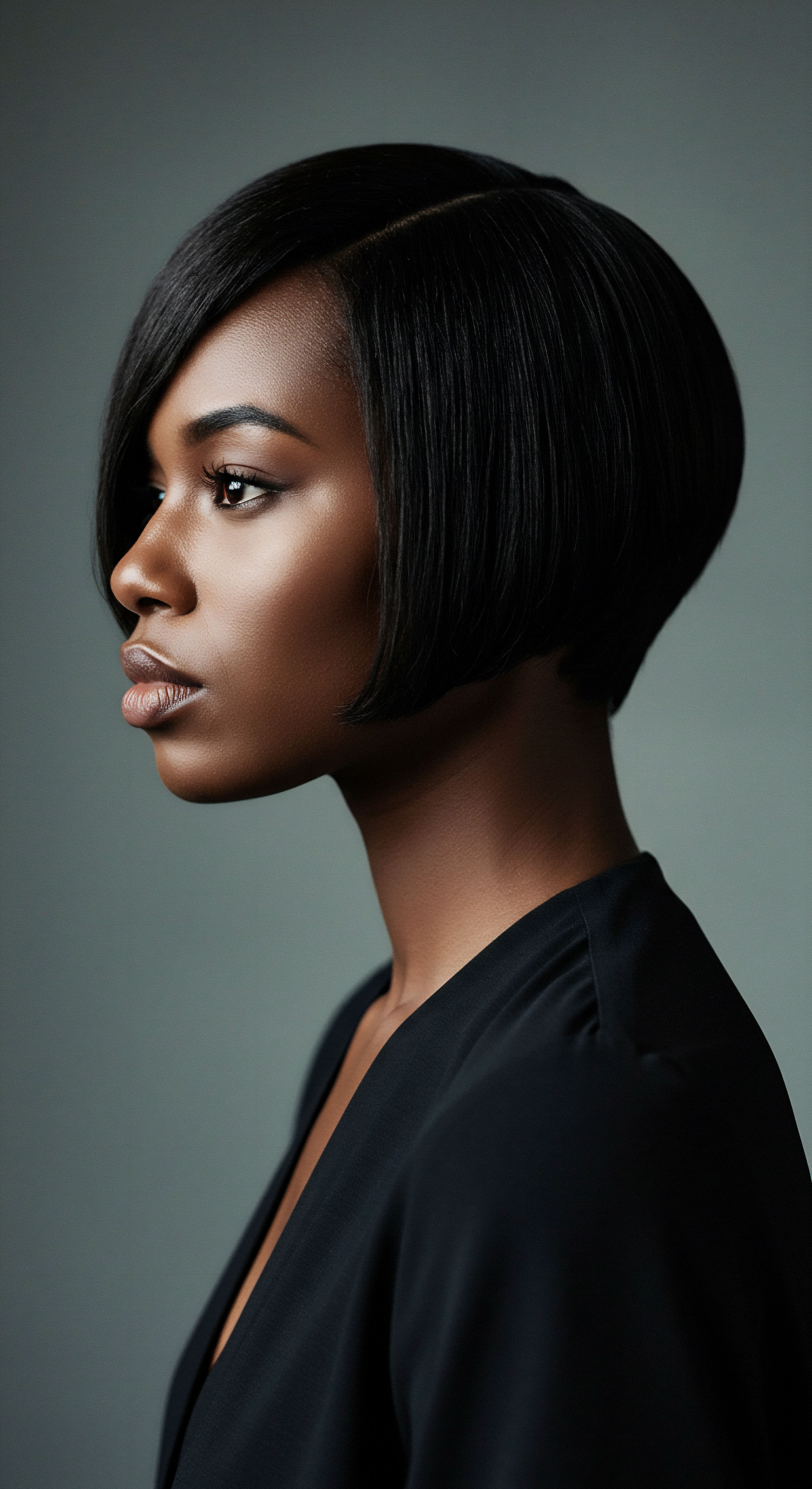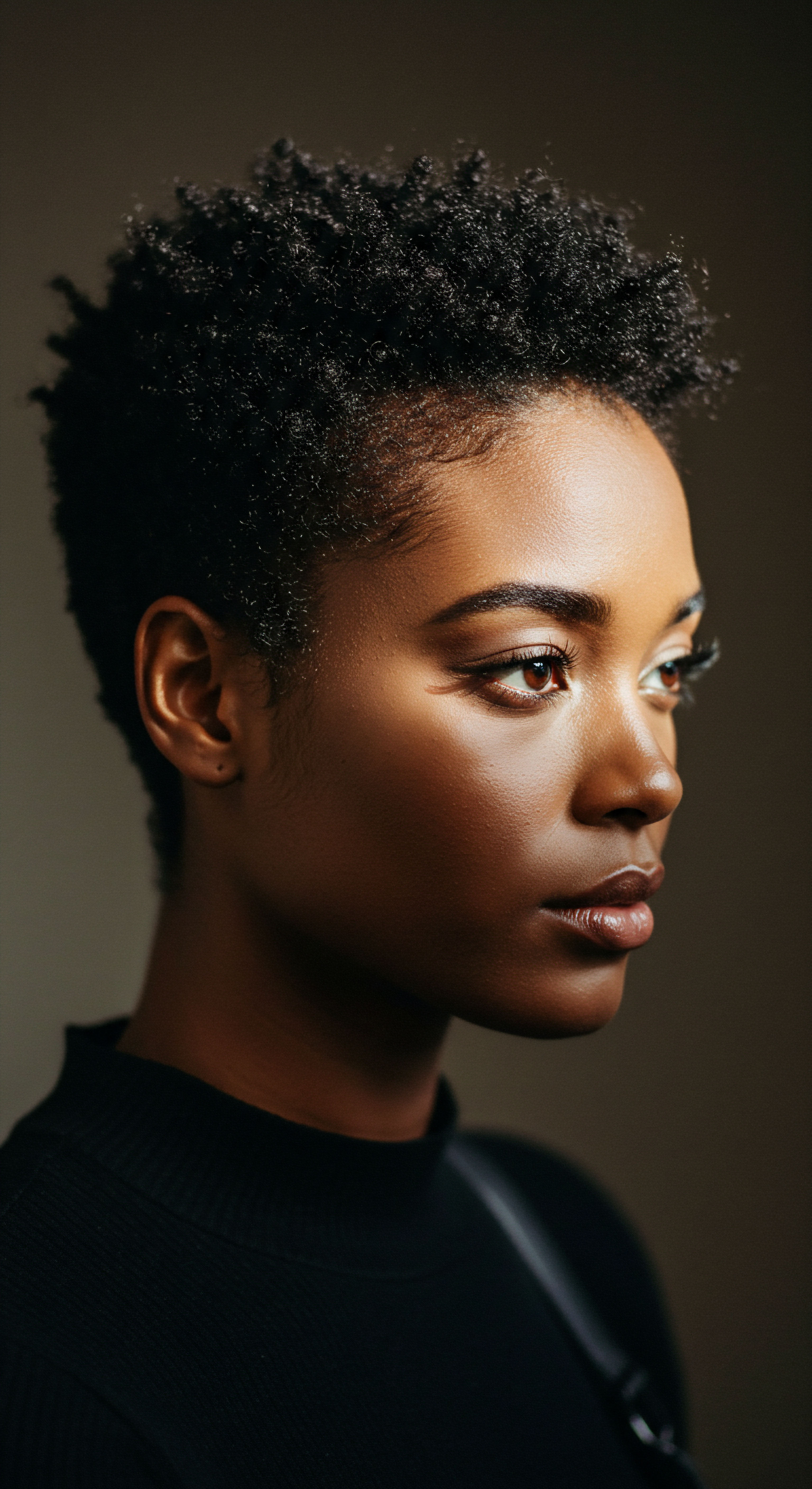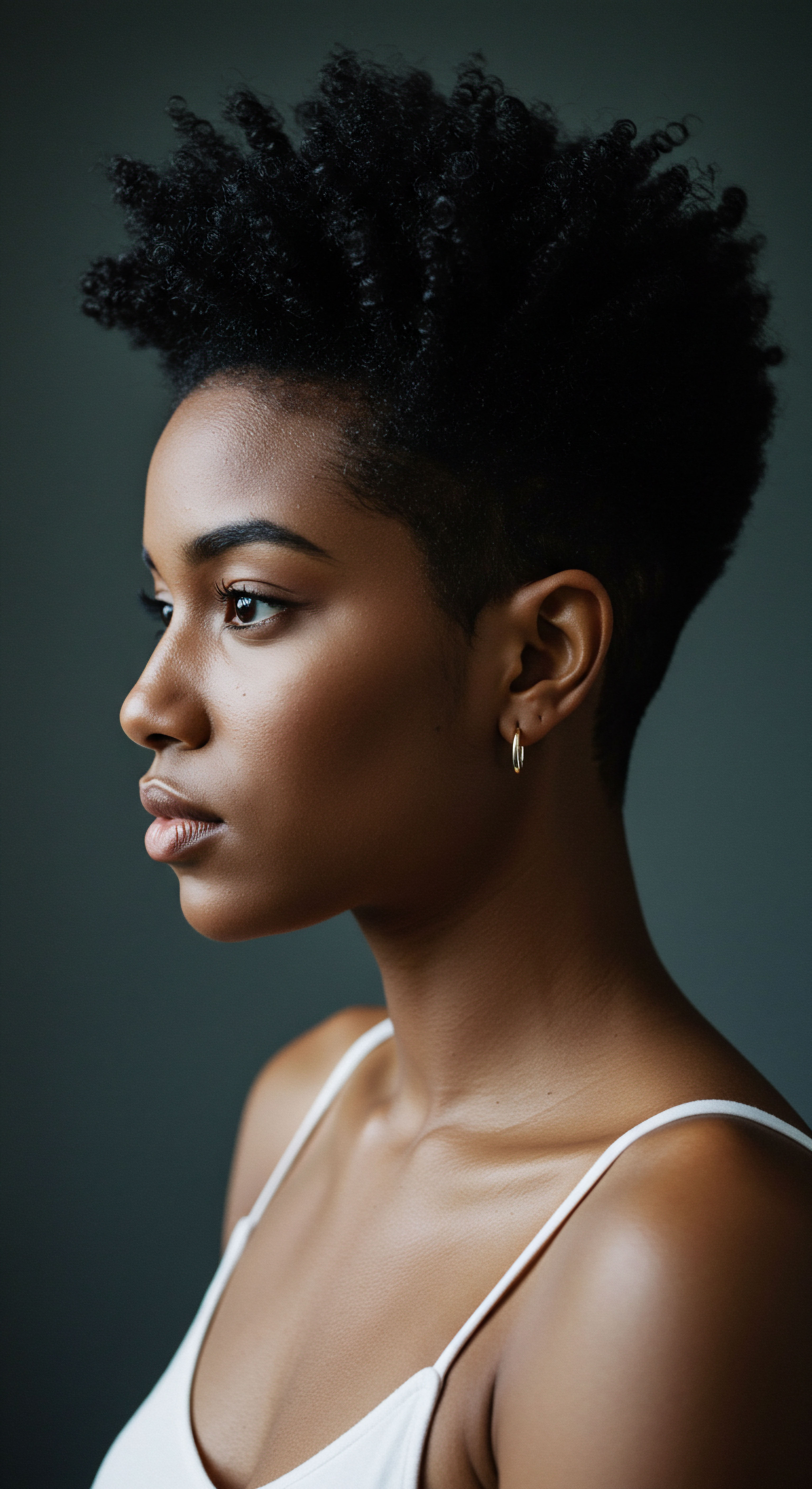
Roots
The whisper of silk against skin, the comforting weight of cotton, the smooth glide of satin—these sensations often accompany the ritual of preparing our hair for rest or venturing into the world. For those with textured hair, the choice of a covering extends beyond mere aesthetic or warmth; it speaks to a profound understanding of scalp health, moisture preservation, and the very integrity of each delicate strand. This exploration delves into the elemental qualities of materials that cradle our crowns, seeking to illuminate how these seemingly simple choices can orchestrate a harmonious balance for the scalp, a foundation for truly thriving hair.

What is Hair Porosity and How Does It Shape Our Choices?
Understanding hair porosity is akin to learning the secret language of your strands. It describes the hair’s capacity to absorb and hold moisture, a quality significantly influenced by the cuticle, the outermost layer of the hair shaft. When the cuticle lies flat and tightly packed, moisture struggles to enter, characterizing Low Porosity Hair.
Conversely, a cuticle with gaps and openings allows moisture to enter with ease but also to escape just as quickly, defining High Porosity Hair. Medium porosity hair, residing comfortably in the middle, exhibits a balanced ability to absorb and retain moisture.
This inherent characteristic guides our selection of hair covering materials. For instance, low porosity hair, which can be resistant to moisture absorption, benefits from materials that create a gentle, humid environment, encouraging the cuticle to lift and welcome hydration. High porosity hair, prone to rapid moisture loss, finds solace in coverings that seal in hydration, acting as a protective barrier against environmental factors. The interplay between your hair’s porosity and your chosen covering is a quiet conversation, influencing everything from frizz to breakage.
Hair porosity, the hair’s ability to absorb and retain moisture, dictates the ideal choice of covering materials for optimal scalp health.

The Scalp’s Delicate Environment
The scalp, a living landscape beneath our hair, demands careful consideration. It possesses its own microbiome, a community of microorganisms that, when balanced, contribute to a healthy environment. When this balance is disturbed—perhaps by excessive heat, trapped moisture, or abrasive materials—conditions such as dryness, irritation, or even fungal infections can arise.
Consider the impact of humidity and air circulation. Covering the hair can shield it from environmental stressors like dust, pollution, and harsh UV rays. However, prolonged covering can also trap heat and moisture close to the scalp, inhibiting air circulation and potentially increasing sweating.
This warm, damp environment could foster fungal growth, contributing to issues like itchiness and dandruff. The ideal hair covering, therefore, acts as a gentle guardian, protecting without suffocating, allowing the scalp to breathe while maintaining a beneficial microclimate.
- Microbiome Balance ❉ A healthy scalp supports a thriving community of microorganisms, crucial for overall hair well-being.
- Moisture Regulation ❉ Materials should assist in maintaining the scalp’s natural moisture levels, preventing both excessive dryness and dampness.
- Air Circulation ❉ Adequate airflow beneath a covering helps prevent heat and sweat buildup, reducing the risk of irritation and infections.

Ritual
The act of covering one’s hair, whether for daily protection or nightly preservation, holds a quiet power, a rhythm woven into the fabric of self-care. It speaks to a mindful intention, a practical wisdom passed through generations. For textured hair, this ritual is not merely about shielding strands from the elements; it transforms into a deliberate act of nurturing, a way to sustain the delicate balance of the scalp and maintain the vitality of curls and coils. This section explores the tangible aspects of this practice, guiding us toward materials that elevate this daily or nightly gesture into a truly beneficial habit.

Which Materials Best Serve Scalp Serenity?
When seeking materials that champion scalp balance, breathability and gentleness emerge as paramount qualities. The objective is to create a protective cocoon that allows the scalp to breathe, minimizing heat buildup and moisture retention that could disrupt its delicate ecosystem.
Silk, a natural protein fiber, stands as a paragon in this regard. Its smooth surface drastically reduces friction, which can lead to breakage and frizz, especially for textured hair. Beyond its gentle touch, silk possesses unique properties that assist in moisture retention without absorbing the hair’s natural oils, helping strands stay hydrated throughout the night.
A 2020 study highlights silk’s hydrating and breathable properties, confirming its capacity to keep hair from drying out and frizzing, while also reducing breakage. This makes it an exceptional choice for those seeking to preserve moisture and minimize static electricity, which can be a common concern in dry environments.
Satin, often a more accessible alternative, mimics many of silk’s benefits due to its smooth weave. While typically made from synthetic materials like polyester, a well-constructed satin covering can still significantly reduce friction against hair fibers, helping to prevent tangles and breakage. However, a key distinction rests in breathability; satin, particularly if made from certain synthetic blends, can trap heat and moisture more readily than natural silk, potentially leading to increased sweating and a less ideal scalp environment for some.
The most suitable materials for hair coverings prioritize breathability and a gentle touch to support scalp health and hair integrity.
Cotton, a widely available natural fiber, offers breathability and softness, making it a comfortable choice for many. It is particularly suitable for those with sensitive scalps or undergoing treatments that result in hair loss, providing a soft barrier. However, cotton’s absorbent nature means it can draw moisture from the hair, potentially leading to dryness for some hair types, especially those prone to dehydration. For this reason, cotton might be better suited as a liner within another covering or for shorter periods of wear.
Bamboo, another natural fiber, is gaining recognition for its exceptional softness, absorbency, and natural antibacterial properties. It is also non-static, a significant advantage for preventing hair friction and flyaways. Bamboo’s ability to absorb and evaporate sweat while remaining breathable positions it as a strong contender for maintaining a balanced scalp climate.

Do Hair Covering Materials Affect Scalp Microbiome Diversity?
While direct studies specifically linking hair covering materials to scalp microbiome diversity are less common, the principles of a healthy scalp environment apply. Materials that promote proper air circulation and prevent excessive moisture buildup are inherently beneficial for the scalp’s microbial balance. Conversely, coverings that trap heat and humidity can create conditions conducive to the overgrowth of certain microbes, potentially leading to imbalances that manifest as dandruff, itching, or other scalp irritations. The choice of material thus plays an indirect yet significant role in fostering a diverse and stable scalp microbiome.
| Material Silk |
| Key Benefits Reduces friction, retains hair moisture, breathable, hypoallergenic. |
| Considerations for Scalp Balance Promotes optimal moisture, reduces static, allows scalp air exchange. |
| Material Satin |
| Key Benefits Reduces friction, generally more affordable. |
| Considerations for Scalp Balance Can trap heat, less breathable than silk, may not retain hair moisture as effectively. |
| Material Cotton |
| Key Benefits Breathable, soft, widely available, hypoallergenic. |
| Considerations for Scalp Balance Absorbent, can draw moisture from hair, suitable for liners or short-term wear. |
| Material Bamboo |
| Key Benefits Soft, absorbent, non-static, antibacterial, breathable. |
| Considerations for Scalp Balance Manages sweat, maintains air circulation, helps prevent microbial overgrowth. |
| Material Selecting materials that complement your hair's unique needs and scalp sensitivity is a foundational step in maintaining balance. |

Relay
To consider hair coverings as mere accessories overlooks a deep, interconnected history of purpose, protection, and identity, especially within textured hair communities. The selection of materials, therefore, becomes a thoughtful relay of ancestral wisdom, scientific understanding, and contemporary wellness. This section moves beyond the surface qualities, seeking to understand the profound implications of material science and cultural context on scalp balance, presenting a holistic view that challenges conventional thought and highlights the intricate dance between fiber and follicle.

How Do Hair Coverings Impact Scalp Physiology and the Cuticle?
The physiological response of the scalp to coverings is a complex area, influenced by factors such as material properties, duration of wear, and environmental conditions. The scalp’s sebaceous glands produce sebum, a natural oil that lubricates the hair and skin. While coverings can shield hair from environmental aggressors, prolonged occlusion, particularly with less breathable materials, can alter the scalp’s microclimate.
This can lead to increased temperature and humidity, potentially affecting sebum production and distribution. An accumulation of sweat and oils, without adequate ventilation, may create an environment less hospitable to the scalp’s natural flora, tipping the balance towards conditions like seborrheic dermatitis or folliculitis.
The hair cuticle, the outermost protective layer, is particularly susceptible to external influences. Friction, a constant threat from rougher materials, can lift and abrade cuticle scales, leading to increased porosity, moisture loss, and ultimately, breakage. Conversely, smooth materials like silk or highly polished satin provide a glide that minimizes this mechanical stress, preserving the cuticle’s integrity.
Research consistently points to silk’s ability to reduce friction and maintain the hair’s surface smoothness, thereby safeguarding the cuticle. This protection is particularly vital for textured hair, which, due to its unique structural characteristics and curvature, is often more prone to mechanical damage and dryness.

Can Hair Coverings Influence Hair Hydration Beyond Moisture Retention?
The relationship between hair coverings and hydration extends beyond simply preventing moisture evaporation. It involves the subtle interplay of environmental humidity and the hair’s own water content. Hair, a hygroscopic material, readily exchanges moisture with its surroundings.
In dry environments, hair tends to lose water, becoming more susceptible to static electricity and brittleness. Here, a covering can act as a localized humidity chamber, creating a microclimate that reduces the rate of moisture loss from the hair shaft.
Consider the often-overlooked role of static electricity. When hair rubs against certain materials, especially synthetics like polyester or nylon, electrons transfer, building up a static charge. This causes strands to repel each other, leading to frizz and tangles, which in turn can cause mechanical damage.
Natural fibers such as Silk, Bamboo, and even Cotton, are less prone to generating static electricity, thus offering a gentler environment for hair. This seemingly minor detail has a cascading effect on hair health, reducing the need for manipulation and minimizing stress on the cuticle.
A fascinating study by researchers at the National Institute for Materials Science (NIMS) and Nihon L’Oréal K.K. explored humidity-responsive hair products. While not directly about coverings, their findings on polyvinyl alcohol (PVA) and cellulose microcrystals (CM) composites reveal a deeper understanding of moisture absorption. They found that adding CM to PVA significantly inhibited the uptake of water molecules into hair films and allowed them to maintain low moisture absorption states for long periods, even in high humidity.
This scientific insight, while applied to product development, underscores the critical importance of materials that can either shield hair from excessive moisture absorption or help it retain its existing hydration, a principle directly applicable to hair coverings. The implication for textured hair, often battling humidity-induced frizz, is profound ❉ a covering that acts as a subtle humidity barrier can preserve style and structural integrity.
The historical and cultural significance of hair coverings also provides a rich context for their practical application. Across various cultures, head coverings have served as symbols of modesty, identity, and status, while also offering practical protection from the elements. In many African and African descendant cultures, headwraps have been integral for centuries, not only as expressions of cultural heritage but also as tools for protecting hair and scalp from sun and heat exposure. This deep-rooted understanding of hair coverings as protective tools, often utilizing natural materials, aligns with modern scientific insights into scalp and hair health.
- Silk ❉ A natural protein fiber that minimizes friction and aids in moisture retention. Its smooth surface helps preserve the hair cuticle, reducing breakage and frizz.
- Bamboo ❉ Valued for its softness, breathability, and natural antibacterial properties. It helps manage scalp sweat and reduces static, contributing to a balanced scalp environment.
- Cotton ❉ A breathable, soft natural fiber, suitable for sensitive scalps. However, its absorbent nature means it can draw moisture from the hair, requiring careful consideration for those prone to dryness.

What is the Role of Covering Fit in Scalp Well-Being?
Beyond the material itself, the fit of a hair covering holds significant sway over scalp well-being. A covering that is too tight can exert undue tension on the scalp, potentially restricting blood flow and contributing to a condition known as traction alopecia. This mechanical stress can weaken hair follicles over time, leading to thinning or loss, particularly at the hairline. Conversely, a covering that is too loose might rub against the scalp, causing friction and irritation.
The ideal fit allows for gentle air circulation, preventing the scalp from becoming overly warm or damp, which can promote an unhealthy microbial environment. It respects the delicate nature of the hair follicles and the skin beneath, ensuring that the covering acts as a protective layer without imposing detrimental pressure or constant rubbing. This balance between security and comfort is paramount for long-term scalp health.
The fit of a hair covering, alongside its material, plays a critical role in preventing mechanical stress and fostering a healthy scalp microclimate.
A study exploring religious headwear and alopecia notes that traction alopecia can result from how headwear is secured and styled, particularly with tight wrapping. This is especially important for individuals with afro-textured hair, who may have fewer elastic fibers attaching hair follicles to the dermis compared to other hair types, making them more susceptible to such tension. This underscores the importance of a mindful approach to how coverings are worn, prioritizing a gentle fit that avoids constant pulling or compression.

Reflection
As we conclude this exploration, a gentle understanding settles ❉ the seemingly simple act of choosing a hair covering unfurls into a rich dialogue between ancient practices, modern science, and personal wellness. It is a testament to the quiet power of thoughtful selection, where every fiber chosen contributes to a larger symphony of scalp balance and hair vitality. The wisdom gathered here serves not as rigid rules, but as a guiding light, inviting each individual to listen to their own hair’s whispers, to feel the gentle embrace of a chosen material, and to step into a space where tradition and innovation dance in harmony for the ultimate well-being of our crowns.

References
- Davis-Sivasothy, Audrey. The Science of Black Hair ❉ A Comprehensive Guide to Textured Hair Care. Sivasothy Media, 2011.
- McMichael, Amy J. and Maria K. Hordinsky, editors. Hair and Scalp Diseases ❉ Medical, Surgical, and Cosmetic Treatments. CRC Press, 2008.
- Rudnicka, Lidia. Atlas of Trichoscopy ❉ Dermoscopy in Hair and Scalp Disease. CRC Press, 2012.
- Sinclair, Rodney, et al. Handbook of Diseases of the Hair and Scalp. Wiley, 1999.
- Sinclair, Rodney, and Vicky Jolliffe. Fast Facts ❉ Disorders of the Hair and Scalp. Karger Publishers, 2013.
- Coelho, J. A. et al. “Human scalp hair as a thermoregulatory adaptation.” Proceedings of the National Academy of Sciences, vol. 119, no. 18, 2022, pp. e2200611119.
- Kanti, V. et al. “The role of scalp skin health in hair growth ❉ A review.” Experimental Dermatology, vol. 31, no. 9, 2022, pp. 1251-1263.
- Keis, K. et al. “Effect of oil films on moisture vapor on human hair.” Journal of Cosmetic Science, vol. 58, no. 1, 2007, pp. 30-38.
- Kumar, M. and D. M. Thappa. “Environmental pollution and hair loss ❉ Fact or fiction?” Indian Journal of Dermatology, Venereology, and Leprology, vol. 89, no. 1, 2023, pp. 10-17.
- Miteva, Mariya. Hair Pathology with Trichoscopic Correlations. Springer, 2018.